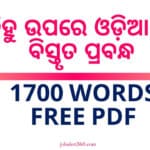Explore the ancient history of Odisha through our engaging MCQ test. Test your knowledge on the fascinating dynasties, historical names, and cultural evolution that shaped Odisha’s past. Dive into the depths of history with our ANCIENT HISTORY OF ODISHA MCQ Test.
Introduction:
Nestled in the heart of India, Odisha boasts a rich and vibrant history that spans over 5,000 years. Known by various names such as ‘Kalinga,’ ‘Udra,’ or ‘Odra Desa,’ the region has witnessed the rise and fall of numerous dynasties, leaving behind a tapestry of cultural heritage and historical significance.
ANCIENT HISTORY OF ODISHA MCQ Test
#1. What is the pre-historic name of Odisha?
#2. Which literary source mentions about Kalinga and Odra and its sacred river Baitarani and Goddess Viraja?
#3. Which literary source mentioned Odisha as Kalinganagara situated on the West of Gomti river?
#4. Which among the following is a Buddhist Literary Source of Odisha’s ancient history?
#5. Greek historian Pliny mentions Odisha by which name?
#6. Which of the following excavation site is not a part of ‘Diamond Triangle’ of Odishan archaeology?
#7. Which of the following inscriptions, throws light on the administration of Asoka in Kalinga?
#8. The earliest coins available in Odisha are ?
#9. Which of the following coins suggest that trade and commerce existed in Odisha?
#10. Which among the following pre historic site in Odisha belongs to Neolithic era?
#11. The capital of Kalinga according to Jain and Buddhist literature in ancient times was-
#12. Who were the rulers of Kalinga before the establishment of Maurya dynasty?
#13. King Asoka became Buddhist after he was horrified with the tyranny of Kalinga War. It was in:
#14. What was the capital of Kalinga after its annexation with Magadha empire? (a) Tosali (b) Samapa (c) Sisupalgarh (d) Dantapur
#15. Hathigumpha inscription in Udayagiri near Bhubaneswar gives information about which dynasty of ancient Odisha? (a) Chedi dynasty (b) Ganga dynasty (c) Satvahana dynasty (d) None of these
#16. Which among these is not a principality of Kalinga during the Guptas?
#17. Which Mathora king declared himself as Lord of the Kalinga? (a) Visakhavarman (b) Shaktivarman (c) Prabhanjanavarman (d) Umavarman
#18. Who among the following transferred his capital from Simhapura to Pishtapura?
#19. Nala dynasty (4-5 century AD) was centered around which modern districts of Odisha?
#20. The Meghas ruled over which part of Kosala?
#21. After the downfall of Gupta empire, many regional kingdoms emerged in Odisha from 6-9th century AD. Which is not one among them?
#22. The territory of the Sailodbhava dynasty was known as
#23. In which royal dynasty of early medieval Odisha, we find the rule of the queens?
#24. Which among the following Queen built the Gauri temple at Bhubaneswar?
#25. The Bhauma-Kara dynasty in Odisha had commercial relations with which country?
#26. For the first time Kalinga, Utkala, Kongodo and Kosala were unified by
#27. Which ruler of Somavamsi dynasty started the construction of Lingaraj temple?
#28. Assertion (A) Kharavela invaded the Satavahana kingdom and captured its territories. Reason (R) Chandravarman declared himself the Lord of Kalinga. Select the correct answers from the codes given below
Ancient Names and Origins:
The name ‘Odia’ itself finds its roots in the Odra or Udra tribes that once inhabited the central coastal belt, specifically Khurda and Nayagarh districts of modern-day Odisha. ‘Udra’ serves as the prehistoric name, while ‘Odisha’ is the contemporary designation for the ancient Kalinga Empire.
Dynasties and Historical Epochs:
Odisha’s political saga unfolds with the rule of the Nandas, who integrated Kalinga into their empire around 350 BC. The Mauryan dynasty, under Emperor Ashoka, fought the transformative Kalinga War in 260 BC. Subsequent dynasties like the Chedis, Murandas, and Guptas shaped the region’s history, leading to the emergence of sub-regional kingdoms during the Gupta period.
Post-Gupta era witnessed the rise of dynasties like Sailodbhavas, Bhauma-Karas, and Somavamsis. The medieval age set in with the Somavamsi dynasty, marking the end of ancient Odisha’s political landscape.
Historical Names:
Throughout its journey, Odisha bore several historical names, each reflecting a unique facet of its identity. From ‘Kalinga’ and ‘Utkala’ to ‘Mahakantara’ and ‘Odra,’ each appellation encapsulates a distinct period and regional influence.
Sources of History:
To unravel the ancient history of Odisha, various sources play a crucial role. Literary sources, including epics like Mahabharata and Ramayana, Puranas, Jaina and Buddhist texts, as well as foreign accounts from Greek historians, provide invaluable insights.
Archaeological discoveries, such as rock art, Asokan edicts, Udayagiri-Khandagiri caves, and excavation sites like Ratnagiri and Lalitgiri, shed light on the socio-economic and cultural aspects of ancient Odisha. Inscriptions, coins, and temple architecture further contribute to the mosaic of historical documentation.
Archival Sources:
In addition to these, archival sources like Utkala Dipika, Utkala Darpan, and newspapers such as Asha and Mukuru, along with census reports from the early 19th century, offer a glimpse into the historical records preserved over time.
Conclusion:
The ancient history of Odisha unfolds like a captivating narrative, with each dynasty, name, and archaeological discovery adding a layer to its rich tapestry. As we delve into the past, we gain a deeper appreciation for the cultural heritage and historical significance that make Odisha a treasure trove of stories waiting to be explored.
ANCIENT HISTORY OF ODISHA MCQ
| Downlaod PDF ANCIENT HISTORY OF ODISHA MCQ | Click Here |
| Odia Official Website | Click Here |
| MCQ Test | Click Here |








